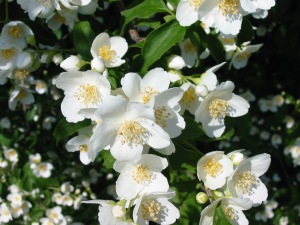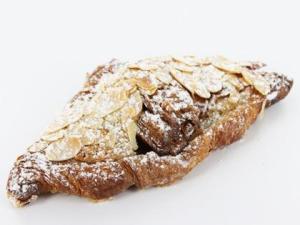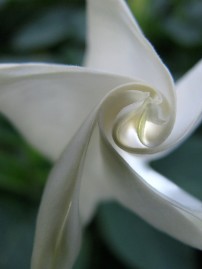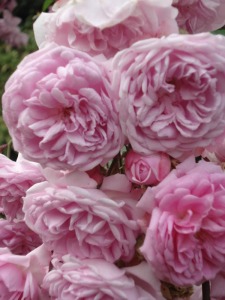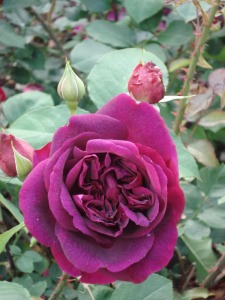Serge Lutens perfumes tend be polarizing. Leather perfumes are also polarizing. Throw the two together and…. Whoa, mama! Yet, I find myself entranced by Cuir Mauresque (“moorish leather”) from The Master. And I don’t even particularly like leather perfumes! This one, though, has just shot up the list to equal Chergui, my previous favorite Lutens, and may even surpass it by a faint whisker. 
One reason may be the fact that Lutens puts Cuir Mauresque in the “Sudden Sweetness” category, alongside Chergui and Musc Koublai Khan. In fact, it does represent a line between those two scents: more spiced, ambered and floral than Chergui, but less musky than Musc Koublai Khan. Yet, in terms of descriptions, Lutens essentially settles for “Moorish” and “leather” as the basic gist for the perfume. It was created in 1996 with Lutens’ favorite perfumer, Christopher Sheldrake, and is a unisex scent for both men and women. Originally, it was released only as a bell-jar fragrance exclusive to Lutens’ Paris Palais Royal salon and was not available for export. In 2010, however, it was made available in the US and worldwide.
I think the reason why I enjoyed Cuir Mauresque so much is because it is not really a leather scent on my skin. Instead, it’s a swirling, seductive jasmine, amber, animalic civet, and spice perfume which just merely happens to have leather undertones. It is a gloriously classique scent that strongly evokes Jean Desprez‘ legendary Bal à Versailles to my nose, though others seem to place it between the equally legendary Tabac Blond from Caron and Knize Ten from Knize.
Fragrantica classifies Cuir Mauresque as a “Leather” and says:
It represents a blend of leather wrapped up in jasmine and sweet spices to make a true Arabian aroma.
Notes: [Egyptian Jasmine] amber, myrrh, burnt styrax [resin], incense, cinnamon, aloe wood, cedar, civet, nutmeg, clove, cumin, musk, mandarin peel and orange blossom.
Cuir Mauresque opens on my skin with a richly heady mix of orange blossom, mandarins, musk, amber, resinous myrrh, nutmeg, cloves and a dry, earthy, (but not skanky) dash of cumin. There is the merest whisper of smoke and incense. Even fainter is the subtle impression of something flowery dancing at the very furthest edge of the notes. There is also, however, that slightly camphorous, chilled note which seems to be Christopher Sheldrake’s signature in many of his perfumes. It is subtle and evanescent on my skin — absolutely nothing like the mentholated, almost rubbery, slightly burnt, camphor note in Tubereuse Criminelle or, to a much lesser degree, in Borneo 1834.
The predominant notes, however, are musky orange, nutmeg and cloves. It’s surprisingly sweet, but there is nothing cloyingly about them. It’s also definitely not gourmand. I think the fruit, the dryness of the spices, and the woody elements cuts through the sweetness, as does the floral note. As the minutes pass, that last note becomes stronger and stronger. It’s jasmine — sweet, heady, and musky but not indolic, sour or over-ripe.
 At first whiff, I did not detect any strong leather note except, perhaps, as just a vague, subtle, ghostly sense. Even then, I wouldn’t bet on it. Ten minutes in, however, there is a definite impression of uber-expensive, luxury car interiors, though interiors doused in very aged cognac. Yes, cognac. There is a definite sense of the dryer, almost woody, nutty aspect of really expensive cognac, as opposed to something sweet, boozy rum. It adds great warmth to the leather which takes on a very creamy, dark, rich feel. It’s more akin to a really old, dark brown, leather jacket than to the scent of a new Chanel purse. There is no impression of coldness nor of soft suede, and most definitely nothing evoking dead animals, barnyard manure or raw animal pelts as some leather fragrances are wont to do.
At first whiff, I did not detect any strong leather note except, perhaps, as just a vague, subtle, ghostly sense. Even then, I wouldn’t bet on it. Ten minutes in, however, there is a definite impression of uber-expensive, luxury car interiors, though interiors doused in very aged cognac. Yes, cognac. There is a definite sense of the dryer, almost woody, nutty aspect of really expensive cognac, as opposed to something sweet, boozy rum. It adds great warmth to the leather which takes on a very creamy, dark, rich feel. It’s more akin to a really old, dark brown, leather jacket than to the scent of a new Chanel purse. There is no impression of coldness nor of soft suede, and most definitely nothing evoking dead animals, barnyard manure or raw animal pelts as some leather fragrances are wont to do.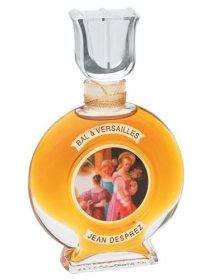
Twenty minutes in, lovely jasmine is the predominant note. It is sweetly spiced and slightly musky, underpinned by that very subtle leather note that has a faintly dirty, animalic, musky element to it, thanks to the civet. I have a definite impression of vintage Bal à Versailles with its heady florals wrapped in amber, musk, civet and resins. I’m not the only one; on Fragrantica, a large number of people seem to think the same way on the Bal à Versailles page. That said, Cuir Mauresque is nowhere near as animalic as Bal à Versailles and not one millionth as skanky. It’s softer, lighter, more spiced, less powdery and without any sweat, fecal or “piss” undertones.
It’s a lovely scent and narcotically heady in that first hour but, also, somewhat indolic. That’s where I fear it will trip up a few people, since indoles can be very tricky depending on skin chemistry. (See, “Indoles” and “Indolic” in the Glossary linked at the very top of the page for more details.) On me, the jasmine is never sour, verging on rotting fruit, or urinous. Instead, the jasmine, orange blossoms and spices are warmed in a lovely way by the styrax resin, the subtle smokiness of the incense, the amber and the musk. But it is the added touch of that animalic civet which is the perfect, crowning touch. It’s not skanky like unwashed panties or unsettling. Instead, it just evokes old-school glamour and seduction.
An hour in, the leather is much more noticeable, as is the animalic civet. However, they both share the stage with the jasmine. To the side, as supporting players, are: honey; very light, subtle incense; and a touch of earthy cumin and dry cloves, with musk and amber undertones.
There is a very classique aspect to the perfume, one which even my mother noted when she smelled my arm. She absolutely adored it, couldn’t smell any leather, thought it had “depth” (her highest compliment), and called it “seductive and mysterious.” I was very taken aback, especially as my mother doesn’t like most of what I give her to smell — Neela Vermeire’s Trayee and Téo Cabanel’s Alahine excepted. Generally, her tastes range from hardcore orientals like vintage Opium, Shalimar and Cartier’s Le Baiser du Dragon, to the classique scents of things like Femme, Jolie Madame, Joy, 1000, Fracas and Bal à Versailles. I suspect that it is Bal à Versailles which led to my mother’s admiration for Cuir Mauresque….
The perfume’s very classique profile led to an interesting discussion when I asked what movie star she would associate with the scent. I kept imagining Marlene Dietrich in her older, less edgy, less hard and androgynous days.
My mother said, flatly and point-blank, “Ava Gardner.” Hardcore glamour, oozing sex appeal, a forceful personality to be reckoned with, and mystery. I countered with the mysterious, seductive, exquisite Princess Fawzia of Egypt. My mother still said Ava Gardner. We both finally settled on agreeing that there was nothing about this scent that could evoke someone cool like Grace Kelly, obvious like Bridget Bardot, or the girl-next-door like Doris Day.
In modern day terms, I thought of Halle Berry in her Bond girl role but that’s not quite the right fit. I can’t really think of someone who does represent the scent for me, not in today’s movie world. Cuir Mauresque isn’t symbolized by a Gwyneth Paltrow type, nor a Jennifer Aniston or Anne Hathaway. This is a perfume for a very strong woman (or man) with a slight edge, a bit of toughness, who radiates seductiveness and mystery, and who entrances as much by the enigmatic gaze as by her long legs or his broad shoulders.
Sometime at the second hour, the leather note does become more apparent but it soon vanishes with the return of the fruity-floral, musky civet, and amber notes of Bal à Versailles. Cuir Mauresque is significantly lighter and less animalic, while also being more tinged by smoke, but the resemblance is noticeable to my nose. The appearance of some sweet powder doesn’t change things as that, too, was in Bal à Versailles. Here, it’s not like baby powder or even like hardcore Guerlainade. It’s hard to describe, but there is a balmy, sweet aspect it.
By the end of the third hour, the perfume is all fruity-florals with honey, resins, musk and faintly powdered vanilla. The leather notes — to the extent that they are there — are very subtle and more like soft suede. Creamy, light and beige. Eight hours later, almost by the end of its duration, Cuir Mauresque turns into nothing more than lovely honey and dried fruit. The dry-down in all those last hours is warm, sweet, and truly cozy. Interestingly, the sillage on Cuir Mauresque was not particularly high. It was noticeable in the first hour, then dropped significantly and became close to the skin by the third hour. Others, like Angela at Now Smell This, have also found the perfume to have persistent longevity but to be “quiet” with moderate to low, sillage. I very much agree.
As you might tell from some of this review, I didn’t find Cuir Mauresque to be a very leather fragrance. I did, however, to be extremely approachable and versatile, not to mention seductive, mysterious and, in the final hours, as cozily delicious as a cashmere blanket. I’m not surprised at all that, according to Luckyscent:
the master himself [Serge Lutens] has gone on record saying he doused himself in [it] on the rare occasions when he goes out. And considering the choice he’s got, that’s saying quite a lot.
He’s not the only one. The Non-Blonde wrote in 2009 that Cuir Mauresque was her “favorite” leather perfume, though the “less easily defined (and probably most controversial)” out of all the many leather scents that she has tried. She added: “I can’t get enough of Cuir Mauresque and tend to murmur sweet nothings at my bell jar[.]”
Angela at Now Smell This found it ” special — warm and cozy, intimate and spicy, different from my other leathers.” On her, the perfume “kicks off with a surprising note that offers a freaky insight into the rest of the fragrance.” It’s a sweet plastic note “that mingles with the fragrance’s leather to remind me of a 1970s faux patent leather purse.” That soon changes, however:
Lest you suspect Cuir Mauresque is headed down a path of discos, bondage, and Tupperware, think again. Cuir Mauresque warms into one of the snuggliest, most welcoming leather fragrances I’ve worn. Its mandarin peel and orange blossom work the way citrus does in baking rather. They keep the composition from cloying but definitely aren’t tart or bracing. The spices — and I’d include cardamom with the listed cinnamon and nutmeg — feel so obviously right with the medium-weight leather. Cumin and musk are just barely noticeable, but they push Cuir Mauresque away from bundt cake toward skin. Warm, luxurious, grandpa-cardigan-wearing skin — that is, if your grandpa has worn his shape into his Bugatti’s leather seats and has publishers clamoring for his memoir.
And Perfume-Smellin’ Things just went weak at the knees for Cuir Mauresque:
Along with Muscs Koublai Khan, I consider this to be one of Lutens’s most sensual, most seductive scents. Cuir Mauresque makes my mouth dry and my knees week. From the slap of pure unadulterated leather in the beginning to the warm, gentle caress of cinnamon and orange blossom at the middle stage, to the wonderful dark, ambery, leathery embrace of the drydown, Cuir Mauresque charmed, enamoured and enslaved me. This being a Lutens scent, it goes almost without mention that the woody accord of cedar and aloe wood (agarwood, the source of ouds) is executed in the most exquisite way; the wood here serves only as a background, but what a luscious, almost sweet background it is! I also adore the way a musk note is woven into the rich tapestry of the composition; even though never too evident, it is there at every stage of the development, adding the raw, animalistic accord that makes the blend all the more irresistible to me.
But, like many Lutens, the love is almost equaled by hate. For all the positive raves on places like Fragrantica or Basenotes, there are a number of negatives that evince pure loathing. Basenotes, to be specific, has 22 Positive reviews, 10 Neutral and 10 Negative. But the most searing, most scathing, and most amusingly repulsed review has to come from the blogger, Nathan Branch, who wrote:
in what seems to be a desire to be willfully obtuse, it contains a compound that smells strongly of piss — which, I suppose, if you’re into gay faux-biker bars and fetishistic watersports, you’d quickly associate with the scent of leather, but is this really the Lutens target audience? […]
In Cuir Mauresque’s defense, the sour aroma of piss does fade as time passes, but it doesn’t fully go away, and I have to admit to not being particularly certain why anyone would reach into their perfume collection and think, “A-ha! Today I want to smell kind of like the windowless back room of a gay leather bar!”
Ouch! Clearly, the indoles in the jasmine turned extremely sour on his skin. But the degree of revulsion in that review and in a few comments on Basenotes led me to wonder.
So, I tried Cuir Mauresque a second time. I strained and strained to find something akin to the notes described but, no, I didn’t. Perhaps, during the second hour, there was a slightly sour note — but I’m pretty sure I found it only by the power of suggestion. Whatever it was, and if it was even there, it was extremely fleeting.
The funny thing is, on both occasions, Cuir Mauresque was not a very leathery scent for me. It was always a seductively jasmine, fruity scent with civet, spices, resin and subtle smoke. It just merely to have a leather undertone — and only on occasion at that! But, as the other reviews up above demonstrate, the perfume can take on a wide variety of aspects, from much more leathery, to notes resembling oud, and, alas, occasionally, also something urinous in nature. Clearly, this is one perfume that needs to be tried first and not purchased blindly, particularly if you have issues with indoles or leather. In fact, I’d say flat-out that those who don’t like either note — but who especially don’t like very heady florals or musky, animalic civet scents — won’t like Cuir Mauresque one bit.
Those who do like leather scents, however, may be interested to know that Cuir Mauresque is repeatedly said to fall somewhere between the old leather greats: Caron‘s Tabac Blond and Knize‘s Knize Ten. Some people also bring up Chanel‘s Cuir de Russie, especially in the dry-down, but I see absolutely no similarity to the latter. On me, Cuir de Russie was pure horse feces cloaked in soap. (I was not a fan, but I recognize that I’m in a distinct minority on that one.)
In Perfumes: The A-Z Guide by Luca Turin & Tania Sanchez, Ms. Sanchez classifies Cuir Mauresque as a “Sweet Leather” and gives it a three-star rating, writing succinctly:
The great leathery classic, Caron’s Tabac Blond, receives the Lutens treatment — more transparent, sweetened with jasmine and dried fruit. Lovely, but somehow less, and no match for, say, Knize Ten.
I’ve never tried either, though I do have a sample of Knize Ten that I will get around to eventually. While I can’t compare Cuir Mauresque to the great leather classics of the past, I think that Ms. Sanchez’s 3-star rating is extremely unfair. My perspective is closer to that of PereDePierre who writes that it is “[a]rguably the best of the modern leather fragrances” and who considers it to be much more of an amber than a leather, one whose “most distinguishing feature is its combination of cinnamon and orange blossom.” I’d toss in jasmine and civet into that mix, but yes, I quite agree.
I also think Cuir Mauresque is a very approachable “leather” that is perfect for people like myself who have some difficulty with the category. But, most of all, I think it’s sexy as hell.


